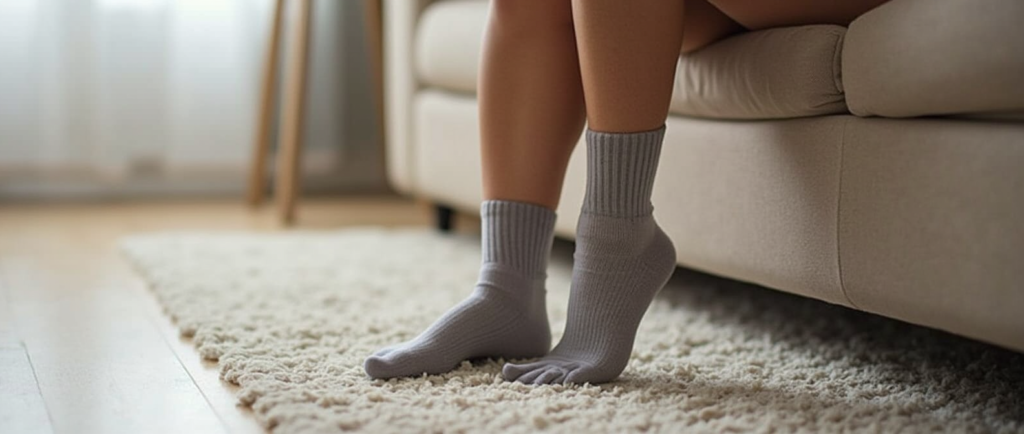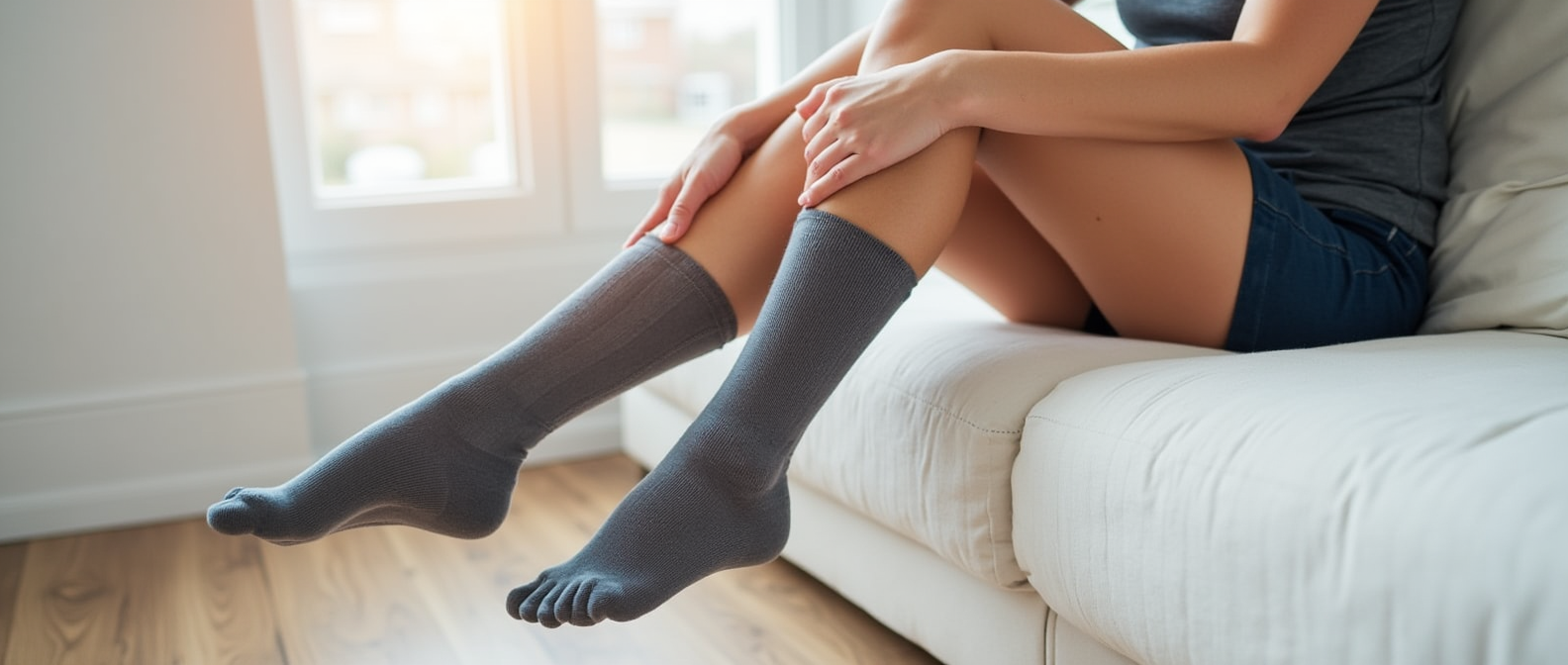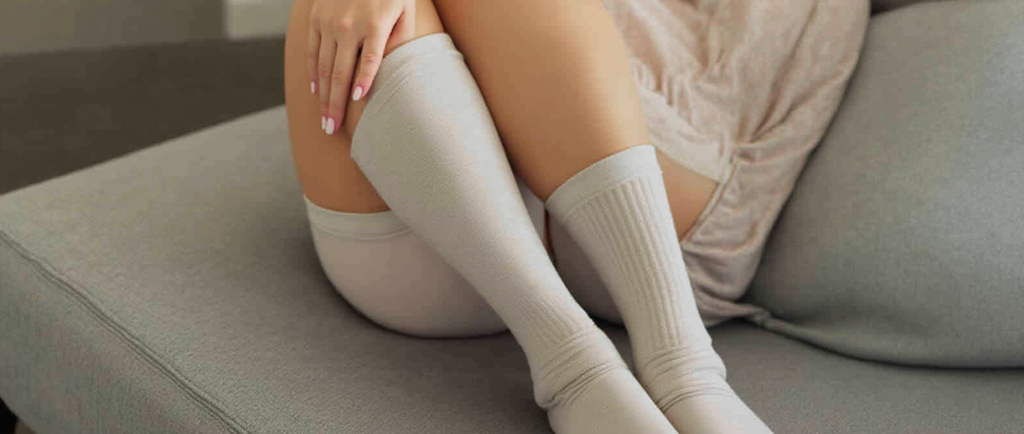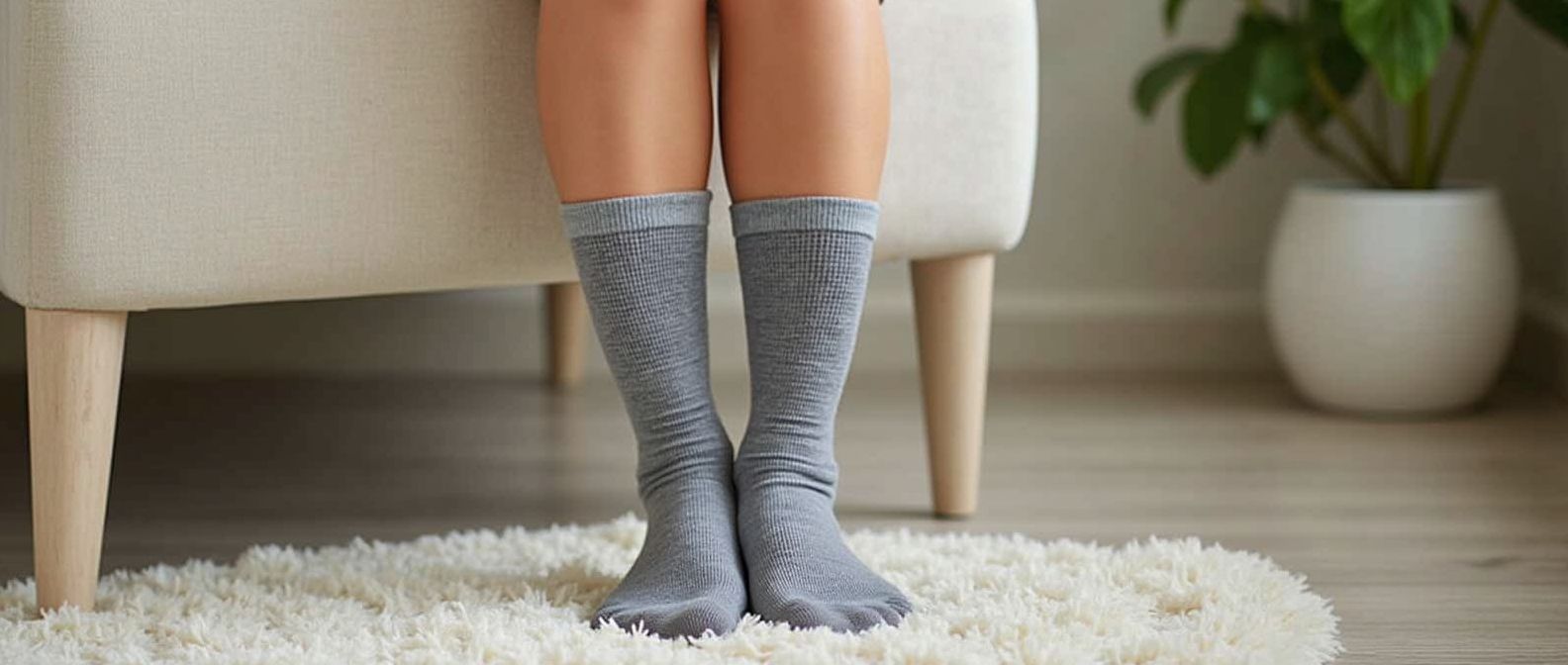If you or a loved one has Restless Legs Syndrome (RLS), finding relief is a top priority. Many people are exploring different methods for managing the constant leg discomfort and urge to move associated with RLS. One question that often comes up is, do compression socks help restless legs? Compression socks are indeed gaining attention as a potential solution, but how effective are they in alleviating RLS symptoms?
Table of Contents
Understanding Restless Legs Syndrome and Its Impact on Daily Life
Restless Legs Syndrome (RLS), also known as Willis-Ekbom Disease, is a neurological disorder. It causes an irresistible urge to move the legs, often with uncomfortable sensations. This condition can deeply affect daily life, disrupting sleep and overall well-being.
Common Symptoms and Triggers of RLS
The main symptoms of RLS include a strong urge to move the legs. People often feel a crawling, tingling, or itching sensation. These symptoms get worse in the evening and at night, making it hard to sleep.
Things that can make RLS symptoms worse include:
- Inactivity, such as sitting or lying down for extended periods
- Stress and anxiety
- Caffeine, alcohol, or tobacco consumption
- Certain medications, such as antidepressants or antihistamines
- Pregnancy or hormonal changes
- Underlying medical conditions, such as iron deficiency or neuropathy
How RLS Affects Sleep Quality and Overall Health
RLS can disrupt sleep patterns. The urge to move the legs can make it hard to fall asleep and stay asleep. This leads to chronic sleep deprivation.
This, in turn, can affect overall health in many ways, including:
- Increased fatigue and daytime sleepiness
- Reduced cognitive function and concentration
- Heightened stress and irritability
- Weakened immune system
- Increased risk of chronic health conditions, such as hypertension and cardiovascular disease
The Economic and Social Impact of RLS
RLS can also have economic and social impacts. It can reduce productivity at work, increase healthcare costs, and make it hard to maintain personal relationships. The condition can also lower the quality of life, as symptoms and sleep disturbances can interfere with daily activities and social interactions.
| Impact | Statistic |
|---|---|
| Reduced work productivity | RLS patients report an average of 8.3 work days lost per year due to their condition. |
| Healthcare costs | The annual healthcare costs for individuals with RLS are approximately $2,700 higher than those without the condition. |
| Quality of life | RLS patients report a significantly lower quality of life compared to individuals without the condition. |
Understanding the impact of Restless Legs Syndrome highlights the need for effective treatments. Options like compression therapy for restless leg relief can improve the lives of those affected by this debilitating condition.

Will Compression Socks Help with Restless Legs?
Many people with Restless Legs Syndrome (RLS) wonder if compression socks can help. Research and stories from others show promise. It seems that restless legs and compression wear might be a good match.
Compression socks work by boosting blood flow. They apply gentle pressure to the legs. This helps blood move better, reducing the pooling that causes RLS symptoms.
People with RLS often find relief with compression socks. They say their symptoms lessen. “I noticed a significant improvement in my RLS symptoms after incorporating compression socks into my daily routine,” one person said. “The constant aching and urge to move my legs has been greatly reduced, allowing me to sleep better and feel more rested during the day.”
Studies are still being done, but what we have so far is encouraging. Compression socks might help manage RLS without drugs. They could improve life for those with the condition.
The Science Behind Compression Therapy for RLS Management
Compression socks are being looked at as a possible help for people with Restless Legs Syndrome (RLS). They work by affecting the body’s blood flow.
How Compression Socks Work on Blood Circulation
These socks apply pressure that gets stronger as you go up the leg. This pressure boosts blood flow and helps with circulation. It can also lessen the pain and discomfort of RLS by reducing waste in the muscles.
Pressure Levels and Their Effects on RLS Symptoms
- Mild compression (15-20 mmHg): Can help improve circulation and reduce the severity of RLS symptoms.
- Moderate compression (20-30 mmHg): Provides greater support and may offer more significant relief for RLS sufferers.
- Firm compression (30-40 mmHg): Offers the most substantial pressure and can be particularly effective for individuals with more severe RLS symptoms.
Medical Research Supporting Compression Therapy
Studies have shown that compression therapy can help with RLS. A 2016 study published in the Journal of the American Academy of Dermatology found that compression stockings improved sleep and lessened RLS symptoms. 1 A 2019 review article in the American Journal of Medicine also found that compression therapy is safe and effective for RLS.2
| Study | Findings |
|---|---|
| 2016 study in the Journal of the American Academy of Dermatology | Compression stockings improved sleep quality and reduced RLS symptom severity. |
| 2019 review article in the American Journal of Medicine | Compression therapy is a safe and effective treatment option for individuals with RLS. |
Compression therapy for RLS shows promise. It can help ease symptoms and discomfort. By understanding how compression socks work and the research backing them, people with restless legs socks compression can make smart choices for managing their RLS.
1. Amin, S., & Chitsazan, M. (2016). The effect of compression stockings on restless legs syndrome. Journal of the American Academy of Dermatology, 74(5), 931-937.2. Trotti, L. M., & Becker, L. A. (2019). Pharmacologic and nonpharmacologic treatments for restless legs syndrome. The American Journal of Medicine, 132(1), 24-35.

Choosing and Using the Right Compression Socks for RLS Relief
Compression socks can change the game for Restless Legs Syndrome (RLS) relief. But, not all socks are the same. It’s key to pick the right pair and use them right for the best RLS relief.
First, think about the compression level. RLS often does well with 15-20 mmHg compression. This pressure boosts blood flow and eases RLS symptoms. But, too tight socks can make things worse, so finding the right balance is crucial.
The material of the socks matters too. Choose breathable, moisture-wicking fabrics like nylon or spandex. These keep your feet and legs cool and comfy, which is vital for RLS management since heat and swelling can make symptoms worse.
Getting the right fit is also key. The socks should be snug but not too tight. Measure your calves and feet to pick the right size. If they’re too loose, they won’t work right. But, if they’re too tight, they can cut off circulation and be uncomfortable.
Wearing compression socks consistently is important. Try to wear them for at least a few hours a day, especially when resting or sleeping. This can help ease RLS symptoms and improve your sleep quality.
Take good care of your compression socks. Wash them gently by hand or in a delicate cycle. Avoid fabric softener or bleach, as they can harm the compression. With the right socks and use, you can find relief from RLS symptoms.
Tips for Choosing the Right Compression Socks for RLS
- Opt for a compression level of 15-20 mmHg for RLS relief
- Look for breathable, moisture-wicking fabrics like nylon or spandex
- Measure your calves and feet carefully to ensure a proper fit
- Wear compression socks consistently, especially during periods of rest or sleep
- Care for your compression socks by washing them gently and avoiding fabric softener or bleach
Do Compression Socks Help with Other Conditions?
Compression socks aren’t just for RLS. They can also help with shin splints by reducing swelling and improving blood flow. They might also help with neuropathy by boosting circulation and easing nerve pain.
| Condition | Potential Benefits of Compression Socks |
|---|---|
| Restless Legs Syndrome (RLS) | Improves blood circulation, alleviates unpleasant sensations |
| Shin Splints | Reduces swelling, improves blood flow to the affected area |
| Neuropathy | Helps improve circulation and reduce nerve-related pain |
Always talk to a healthcare professional before using compression socks for your condition. They can help decide if they’re right for you.

Conclusion
Compression socks can help with Restless Legs Syndrome (RLS). They improve blood flow and offer targeted pressure. This can ease symptoms like leg pain, twitching, and trouble sleeping.
But, they shouldn’t be the only treatment for RLS. It’s best to talk to a doctor about the right treatment plan. This might include lifestyle changes, medicine, and compression socks.
More studies are needed to fully understand how compression socks help with RLS. Yet, they offer a simple way to manage symptoms. Using compression socks can improve sleep and reduce symptoms, helping people take back control of their lives.
FAQ
Can compression socks help with restless legs syndrome (RLS)?
Yes, research suggests that compression socks can help with RLS. They improve blood flow and reduce discomfort. This can ease the symptoms of RLS.
How do compression socks work to alleviate RLS symptoms?
Compression socks apply pressure to the legs. This improves blood flow and prevents blood from pooling. It relaxes muscles and reduces the unpleasant sensations and movements of RLS.
What level of compression is recommended for RLS relief?
For RLS, socks with 15-20 mmHg to 20-30 mmHg pressure are suggested. This moderate pressure promotes circulation without being too tight. Always check with a healthcare professional for the best fit.
Are there any medical studies supporting the use of compression socks for RLS?
Yes, studies show that compression therapy is effective for RLS. It can reduce symptoms, improve sleep, and enhance life quality for those with RLS.
How should compression socks be worn for the best RLS relief?
Wear compression socks in the evening and at night when symptoms are worse. Make sure they fit well, from foot to just below the knee. Proper care keeps them effective.

